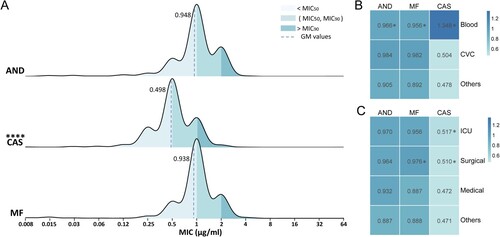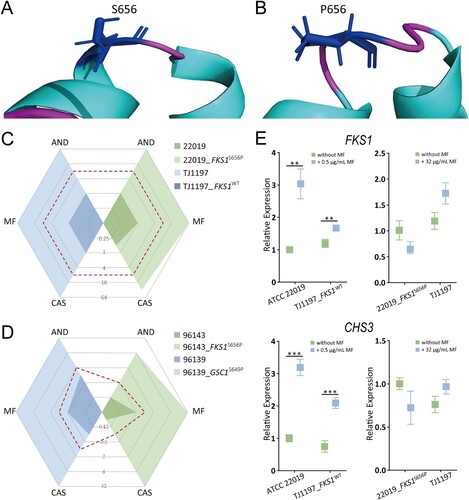Figures & data
Figure 1. Profile of C. parapsilosis susceptibility to echinocandins. (A) Distribution of susceptibility to three echinocandins of 2523 clinical isolates from China collected by CHIF-NET 2015–2019 programme. (B and C) Susceptibility differences of isolates regarding different samples (B), and hospital departments (C). Geometric mean of the MIC (GM) values are shown in the boxes; differences between each two groups were analyzed, while only significant differences compared to the “others” group are shown in the figure. AND, anidulafungin; CAS, caspofungin; MF, micafungin. *, P < 0.05; ****, P < 0.0001.

Table 1. Clinical characteristics of a patient with breakthrough candidemia caused by pan-echinocandin resistant C. parapsilosis.
Figure 2. Strain characteristics of the pan-echinocandin resistant C. parapsilosis clinical isolate. (A) In vitro susceptibility to nine common antifungal drugs. The dashed red line indicates the breakpoints for defining drug resistance or cut-off values for non-wild type. (B) Transmembrane helix predictions for Fks1 of C. parapsilosis. The location of the amino acid 656 is labelled.

Figure 3. Structural and functional effect of the S656P substitution in Fks1. (A) The predicted structural model for the variants of the Fks1 protein (amino acids 400∼900), the S656P substitution would result in the helix-to-coil transition, disrupting conformation of this ɑ-helix. (B) Echinocandin MICs for susceptible C. parapsilosis strain ATCC 22019 and its mutant harbouring Fks1 S656P, and the pan-echinocandin resistant clinical isolate TJ1197 and its mutant with WT of Fks1. (C) Changes in expression of the FKS1 and CHS3 genes in response to micafungin at the sub-MICs. (D) Echinocandin MICs for susceptible C. orthopsilosis ATCC 96139, C. metapsilosis ATCC 96143, and their mutants carrying homologous modifications, S649P and S656P, respectively. Dashed red lines indicate the breakpoints for defining drug resistance or cut-off values for non-wild type. AND, anidulafungin; CAS, caspofungin; MF, micafungin. **, P < 0.01; ***, P < 0.001.

